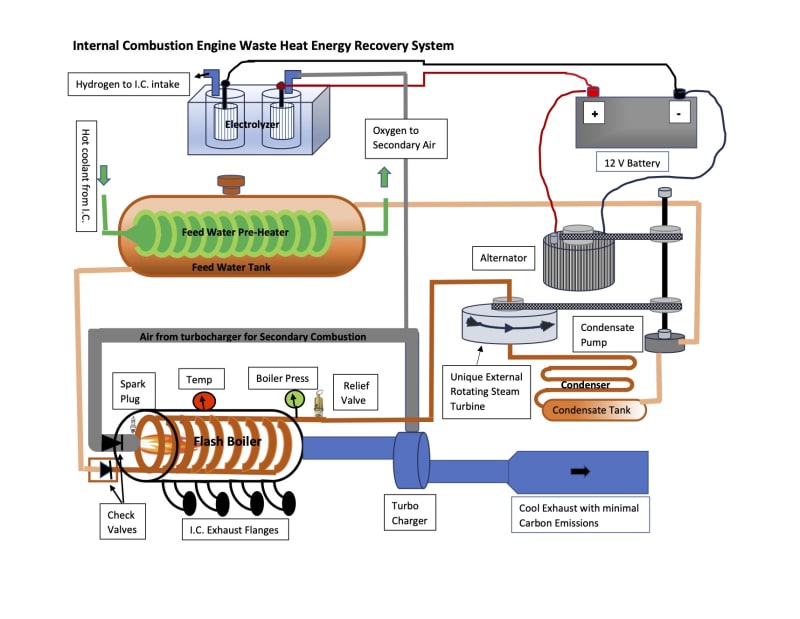Internal Combustion Engines have become an integral part of our society over the last 125 years due to their convenience, power density, range, and many other virtues. Unfortunately, they also are damaging our environment due to the fact that they are only 20 - 30% Thermally Efficient because as soon as the Oxygen in the air charge (21%) needed for combustion drops below the sustainable Air / Fuel Ratio the fire goes out! This system uses some of the heat energy and unburned Carbon Molecules remaining in the exhaust, plus Air (Oxygen) provided by an Exhaust Driven Turbine (Turbocharger) to create Secondary Combustion of the remaining Hydrocarbons, Generating Flash Steam to power a Unique External Rotating Steam Turbine. This Turbine drives an Alternator, charging the electrical system, eliminating the Alternator load on the engine, plus powering an Electrolyzer to provide supplemental Hydrogen to the Fuel System. NASA has experimented with Supplemental Hydrogen and has achieved as much as 15% reduction in Fossil Fuel consumption. Hydrogen also burns 3 times faster than fossil fuels which improves the overall combustion process, reducing emissions.
The Process:
- Heat from the I.C. engine exhaust can reach 400 - 500ᵒ F, and begins heating the water in the Flash Boiler coils contained in the boiler housing in the exhaust.
- Supplemental Air provided by a Turbocharger in the exhaust stream and enhanced by Oxygen provided by the Electrolyzer, is combined with unburned Hydrocarbons remaining in the exhaust and ignited by a simple ignition system causing secondary combustion in the Flash Boiler increasing the Temperature in the boiler housing to as much as 1200ᵒ F. (think Catalytic Converter).
- Oxygen in the Secondary Combustion combines much of the CO from incomplete combustion into CO2 and any remaining Hydrogen into water, significantly reducing emissions.
- Superheated Steam from the Flash Boiler causes the External Rotating Turbine to rotate, driving the Alternator plus a Condensate Pump, which completes a closed Condensing Steam system.
- Engine Coolant circulates thru a Pre-heater inside the Feed Water Tank which pre-heats the Feed Water to the boiler and reduces the work load on the Radiator.
- The Electrolyzer splits water / Electrolyte into Hydrogen and Oxygen providing Supplemental Fuel and Oxygen.
This System can be constructed from off the shelf components and readily available materials, and utilizes existing technologies. Steam power has been around for over 200 years and Secondary Air systems have been used by most major Automobile Manufacturers to optimize Catalytic Convertors. Electrolyzers have been discredited as providers of Supplemental Fuel because the load on the electrical system results in a net zero at best, but this system utilizes otherwise wasted energy.
Like this entry?
-
About the Entrant
- Name:David Droz
- Type of entry:individual
- Patent status:none


